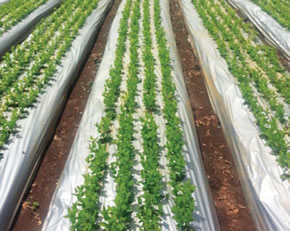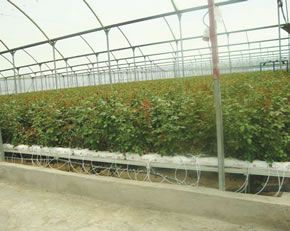 Hydroponics is fancy name for growing plants in soilless media with a nutrient solution. Humans started dabbling in hydroponics as far back as 1670 when it was discovered that plants grew better in ‘dirty’ water than in distilled water. Hydroponics became a great way to identify the essential nutrients for plant growth, and the minimum and maximum levels required. Hydroponics gives complete control on nutrient availability.
Hydroponics is fancy name for growing plants in soilless media with a nutrient solution. Humans started dabbling in hydroponics as far back as 1670 when it was discovered that plants grew better in ‘dirty’ water than in distilled water. Hydroponics became a great way to identify the essential nutrients for plant growth, and the minimum and maximum levels required. Hydroponics gives complete control on nutrient availability.
In Kenya hydroponics is relatively new, becoming popular in the last 15-20 years. The initial move from soil to hydroponics was prompted by the banning of the soil fumigant, methyl bromide, and a general decline in production over time in plants grown in the same soil. It was soon discovered that managed well, hydroponics could be more productive, with better quality and less disease pressure. Hydroponics is generally restricted to high value crops, like roses, but more and more we are seeing tomatoes, capsicum, herbs, leafy vegetables and summer flowers in hydroponics.
Why do hydroponics produce more? In any growing system the production and quality is determined by limiting factors and pest and disease pressure. Moving into a sterile media removes the pressure from the nematodes and the diseases that had built up in the soil. It also gets rid of the soil problems that can build up over time: – compaction, nutrient in-balance, acidification, lime build up or sodium build up. The biggest improvement to growing in the hydroponics vs. soil is oxygen. Oxygen is the most essential plant nutrient, which we sometimes forget. Hydroponic roots have access to much more oxygen, function better and take up more nutrients, hence the big increases in production. These days it is possible, with a good soil testing laboratory and moisture probe to maximise production in soil. Yellow leaves in soil grown roses due to oxygen starvation from over-watering – one of the main benefits of hydroponics is increased oxygen levels in the root zone.( a good soil moisture probe will stop this!)
In Kenya, media mainly consists of coco peat, coco fibre, pumice and/or gravel. The media forms a support for the roots, and stops the plants falling over. A nutrient rich solution is dripped through this media, continually refreshing the nutrients in the root zone. Water and the nutrients that are not taken up by the plants drain out the bottom. Plant roots have access to oxygen nearly all the time. The effect of over watering is not felt as strongly as in soil culture because the media drains so easily. The excess water is collected and re-used, hence the dramatic water& fertiliser saving.
The media should be stable, non-compact and inert. Stable, because a media that breaks down quickly would kill the plants. Non-compact, because free drainage is the key to good hydroponics. Inert, because the idea is to feed the plant exactly what it needs via the nutrient system with no contribution from the media. This is the second reason hydroponics can be more productive that soil.
Before use the media should go through a risk assessment. After all, you are investing so much money in a top end system, it would be terrible for the project to fail because of cutting corners. Due to the nature of hydroponics and the movement of the nutrient solutions through the whole system, nematodes and diseases can spread and build up very fast. It is important to start clean and grow clean.
Coco products come from coastal areas and bring with them a risk of high sodium. They should be expanded, soaked in calcium nitrate (calcium is King!) and flushed to remove any sodium. It’s a good idea to back this up with a laboratory analysis. Young plants are very susceptible to high sodium and salinity. Coco products are plant materials and can contain nematodes and disease spores. These should be tested in an independent laboratory. Pumice is a very nice, local, cheap media that Kenya is blessed with. However it too comes with risks.
Pumice can have high potassium and other toxic ions. It needs to be tested and flushed. Pumice & gravel can be supplied with a fine silt/dust, which gets into the hydroponic system and cause blockages.
Another reason for ‘washing’ it. One problem that we are encountering more and more in our laboratory is nematodes. Pumice & gravel can come from shallow quarries, and already have had plant roots in them. These are associated with nematodes. Get your media tested. If you have nematodes, treat it before use. Solarisation or steaming are good. Another major fault we see on many farms is the storage of the media before use. Once it’s been expanded/sieved/flushed etc., it is often piled up in a corner, uncovered except for a fine crop of weeds. This introduces weed seeds, nematodes, insects, and diseases. Protection of the media is most important.
Feeding your hydroponics Start at the beginning and get the source water analysed. Because plants take exactly what they need out of the nutrient solution and leave

what they don’t you can get a rapid build-up of toxic ions: – sodium, chloride, aluminium, boron, & molybdenum. If you have unsuitable water, reverse osmosis or rain water are good solutions. If you have high carbonates, the water can be acidified before use. A high turbidity or organic load from algae also creates problems with blockages and phyto-toxic breakdown products.
Get professional advice for a good recipe. Different crops, different crop stages, different media and water qualities all require different recipes.
Daily/hourly/continual testing of the EC and pH of the drip and drain is very important. A slight change in plant growth due to crop stage, light levels, temperature, humidity etc. can cause a big change to your nutrient solution. Monitor the drip and drain volumes so that the amount of water applied is optimum and the media is getting flushed often enough, but not too much, most farms work on a 20-50% drain. A high EC in the drain than the drip indicates that the plants are just taking up water, and there is a problem somewhere.
Routine laboratory analysis of the drip and the drain should be done at least every 2 months. Some media’s are not as inert as we think, and toxic ions can build up– in which case get the media tested as well. Hydroponics is all about fine tuning and nutrient optimisation, so leaf analysis every 6 months and not just when the crop goes yellow is recommended. This allows you to pinpoint any hidden hungers that might be limiting production, but are not obvious when looking at the crop. The amount and mixture of fertilisers in the A, B and C Tank is critical. Iron can be lost out of your system at this stage, due to high or low pH and UV light. Use an iron chelate designed for your pH’s, and protect the tanks from light. Adding too many fertilisers can cause precipitation. There is a maximum amount the water can hold. An optimum dilution rate is 150-200. The combination of fertilisers is also important. Mixing calcium nitrate with sulphates precipitates gypsum. The metallic micronutrients and chelates have a complex interaction, and your main iron source should be separated from the other micronutrients. When acidifying alkaline water always take into account the nutrient benefit of the nitric or phosphoric acid that you have to add. Fertiliser mixing is a complicated science which is why a drip analysis is so important.
Re-cycling
One of the main drivers for hydroponics is the environmental benefit due to water saving. If you then release your drain water into the environment, this benefit will not only be lost, but has an even worse effect on the environment than soil culture due to the nutrients in the water that cause eutrophication of the waterways. The water and fertilisers should be recycled. But having passed through all those plant roots, there is a risk of nematodes, diseases, toxic ion build up and nutrient in-balance. Nematodes and diseases can be removed with heat treatment, UV Sterilisation or Ultrafiltration. UV sterilisation is generally not effective due to the dark colour of the water from the iron chelates. Heat treatment is expensive, energy intensive and only effective with a constant and reliable power source. A slight drop in temperature, and all those nematodes and diseases go back into the system.
Ultrafiltration is my favourite. It keeps the nutrients in and filters the problems out. It is effective for dark solutions and unstable power. Once the water has been treated it is important to store it in a clean covered tank. Toxic ion build up and nutrient in-balance can be identified and remedied with a water analysis.
Take into account the nutrient content of your re-cycle water. For example if you are using 40% re-cycle water and 60% reverse osmosis water, your feeding regime should be designed on this.
Hydroponics can be so much more rewarding than the soil, but is also less forgiving! A good risk assessment, a proper testing regime, extra knowledge and much closer management are required. Investing into a complete system with no scrimping on equipment, and proper water treatment is essential. The increased production & quality, savings on water and fertilisers, quicker pay back times and environmental benefits, make the higher initial investment worth it.
